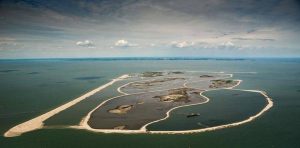DECEMBER 16, 2018
 Signs of life: The Marker Wadden, artificial islands located in the Markermeer lake in The Netherlands. The Markermeer is one of Europe’s largest freshwater lakes. | Photo Credit: AFP
Signs of life: The Marker Wadden, artificial islands located in the Markermeer lake in The Netherlands. The Markermeer is one of Europe’s largest freshwater lakes. | Photo Credit: AFP
The archipelago of five islets was created under an ambitious project, and it has already attracted greylag goose, common tern, and several species of waders
Dutch ranger Andre Donker sighs as he looks out at the rippling grey waters of the Markermeer, one of Europe’s largest freshwater lakes. “Once upon a time it was teeming with fish here,” he said.
But this vast 700-square-km expanse of water, which regulates the level of water in the rest of the Netherlands, had become until recently nothing more than a cloudy mass devoid of aquatic life.
Now the hope is that a new artificial archipelago of five islands will bring nature back to the area via a typically ambitious engineering project for a low-lying country that has battled the sea for centuries.
It is “one of the largest rewilding operations in Europe”, said Mr. Donker.
Standing on a wooden bridge over a pond in the middle of experimental plots of different kinds of reeds, he says he has been able to see the first signs of increasing biodiversity.‘We had to intervene’
The lake was once part of the Zuiderzee, an engineering wonder of the world completed in 1932, which closed off a huge expanse of water to keep out the North Sea and combat flooding.
Vital in a country where 26% of the land is below sea level, the scheme created an inland lake and polders, land reclaimed from the sea, but at a cost to the environment.
Over the subsequent decades, sediment used to create a dyke separating the Markermeer from a neighboring body of water, the Ijsselmeer, washed away and sunk to the bottom of the lake.
That turned the water cloudy, negatively impacting fish and bird populations, plants and molluscs.
“We had to intervene,” said Mr. Donker, wearing a woollen hat to brave the storms from the North Sea.
The solution was a bold one in keeping with a country whose people like to boast that “God created the world, but the Dutch created the Netherlands”.
About 8 km from the port of Lelystad, the ranger walks down the side of an artificial sand dune. Other similar dunes stretch out beyond it as far as the eye can see.
Still-sparse vegetation covers a large part of the 700 hectares that have been built anew in the lake.
The islets plan is among many being worked on by the Netherlands, which is one of the most vulnerable countries in the world to climate change.
Since October, the port city of Rotterdam has hosted the headquarters of an international climate commission led by former UN secretary-general Ban Ki-moon and Microsoft founder and climate activist Bill Gates.
‘Explosion of plankton’
The five islets were built in two and a half years and have already served as a resting place for 30,000 swallows this year.
In the water there is an “explosion” of plankton that “guarantees a large amount of food for the birds”, said Mr. Donker.
Greylag goose, common tern, several species of waders such as the great egret and the night heron have also returned, testifying to the islands’ success.
In the distance a dredger is helping to create the final dunes of the archipelago, dubbed Marker Wadden.
The project, initiated by Natuurmonumenten, a Dutch non-governmental organization, cost €60 million ($68 million) — much of it donated by individuals.
True to their reputation as masters of water management, the Dutch used an innovative technique, forming the islets with silt, a sedimentary formation halfway between clay and sand.
“Building an island with sand is not that difficult, we do it all over the world, and what is unique here is that we use silt,” said Jeroen van der Klooster, project head at Boskalis, the maritime service provider that built the archipelago.
Courtesy/Source: AFP










































































































